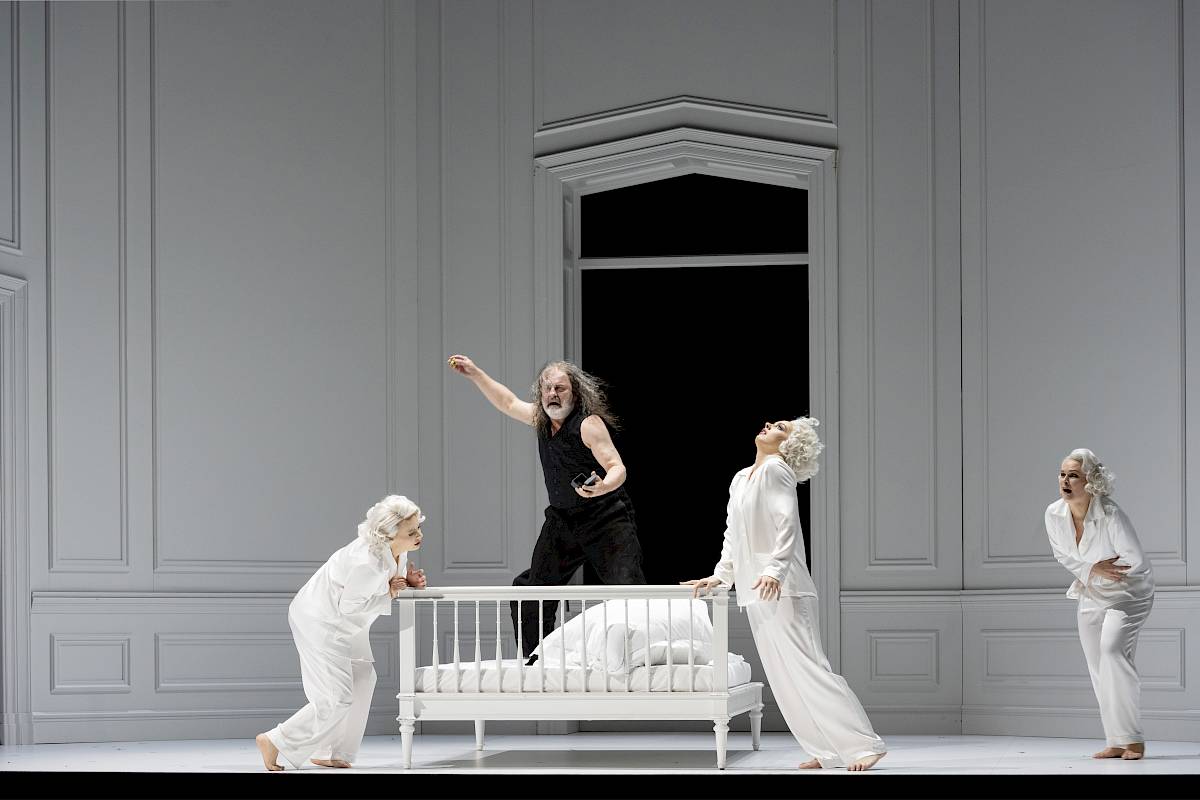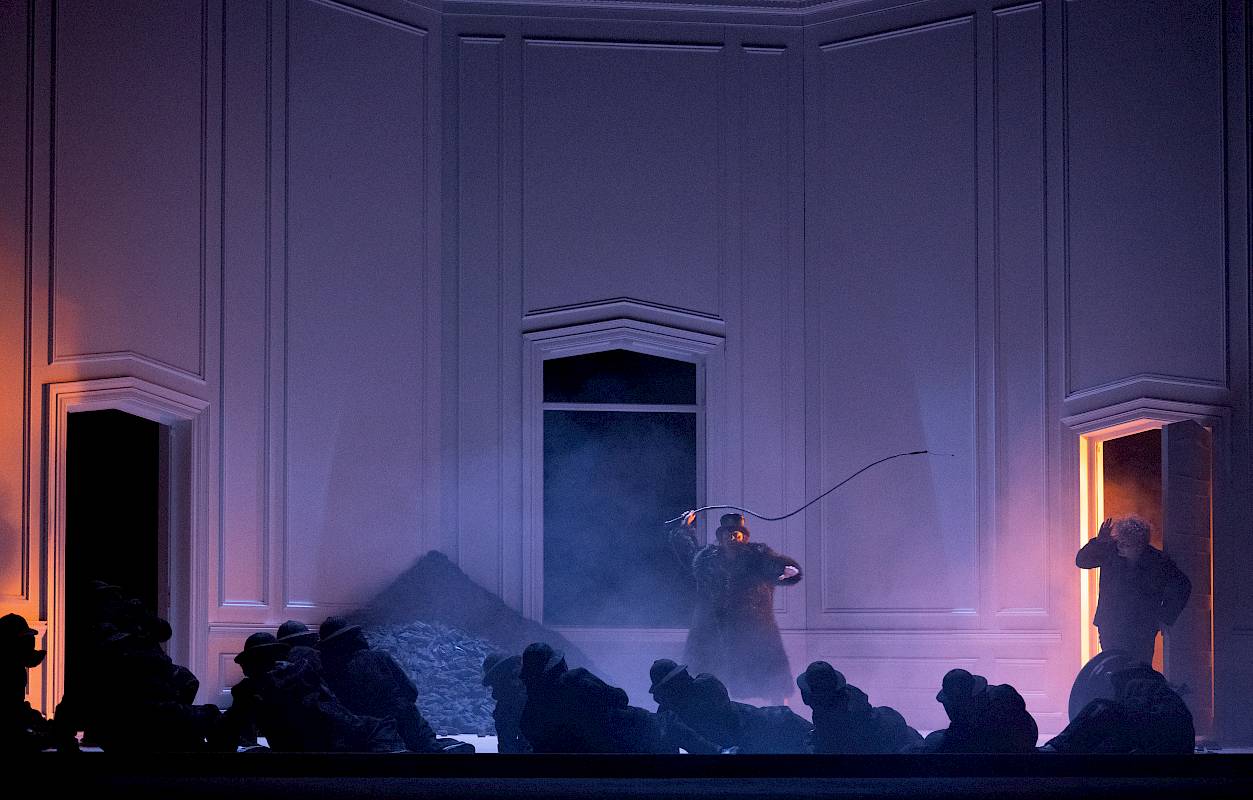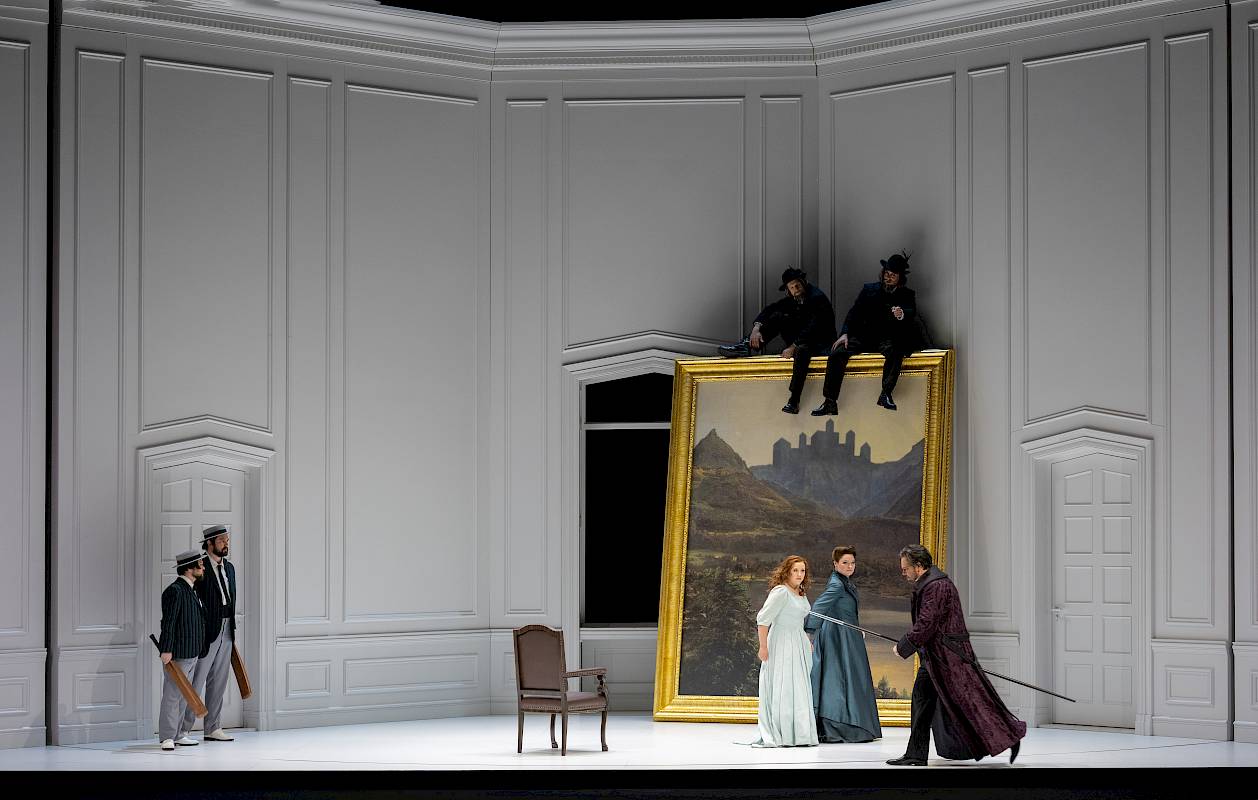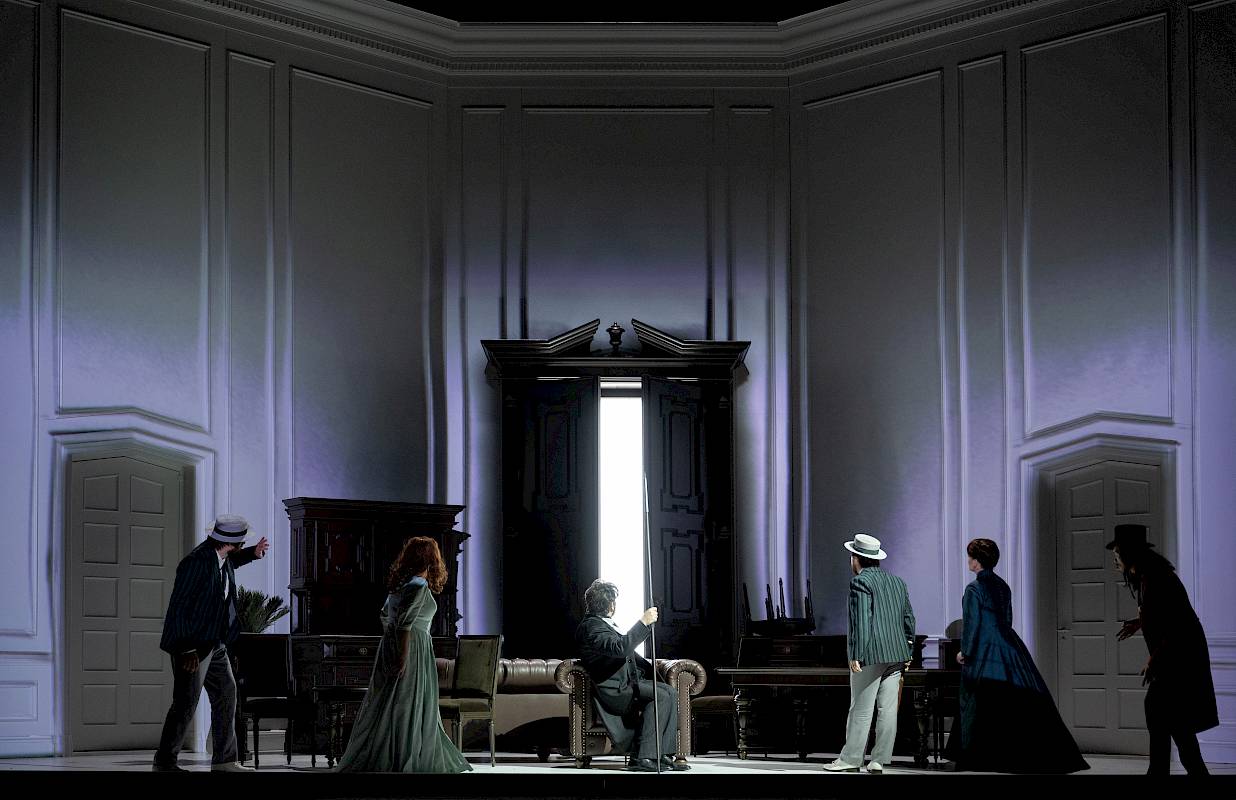Could this be the summer Bayreuth finally sees a new Ring production that comes anywhere near its last great epic success, Harry Kupfer’s, which ran from 1988-92? If so, it’s been pipped to the post by a rather more comfortable and bijou opera house on the other side of the lake to the refuges where Wagner worked on more masterpieces – beautiful sites both, even if the “asyl” next to the Villa Wesendonck is no more..
Zurich Opera’s Intendant Andreas Homoki, following a mixed record to date as director and designer, has taken the plunge with Music Director Gianandrea Noseda to dazzle with the most elegant and funny (yes) Rheingold I’ve ever had the good fortune to see. I got to talk to them – and to Christopher Purves, the phenomenal Alberich (featured in a full Q&A today) – after the big first night, on the afternoon of the second performance. All were charged with energy and radiated happiness. One thing I missed, alas: the light show on the Opera House facade which preceded the opening performance, but you can see it here.
The Covid years gave plans longer to take shape, beginning significantly at the end of March 2020. “We had lots of time,” says Homoki, “so we sat down and had Skype conferences every day for three hours, just talking about the Ring without time pressure, then having a few days’ break, listening to the piece again, reading the text, then continuing, without knowing at all what it was going to look like.” Plans for such a venture always have to be sorted years in advance, “so you have the same singers throughout the cycle, and the same for the two complete cycles.” The whole will be up and blazing in one and a half years, with Die Walküre and Siegfried this coming season and Götterdämmerung in October 2023, with two full cycles taking place the following spring.
Like Homoki and Noseda, the Brünnhilde and Siegfried will be taking on a Ring for the first time. I enthuse about Homoki’s Zurich Flying Dutchman with Bryn Terfel and Camilla Nylund, and he says that revival was the best. It also made him realise Nylund would be ideal for Brünnhilde: “ I thought [of her Senta], this is so special and so strong; I don’t want these screaming Brünnhildes, I want this warm flow of emotion, and she would be perfect for that. A little later I called her and said, would you do Brünnhilde, she said, let me think, and two days later, she said, I’ll do it.” Homoki’s Rheingold is much the funniest I’ve seen, and he hopes the comedy will be rekindled in Act One of Siegfried, with the odd couple of Mime and his foster-son. “That has to be charming, you have to really like Siegfried. That’s why I’m happy we have Klaus Florian Vogt, because there’s no violence there, he has this fresh, sympathetic character – the naivety of Siegfried, there has to be a great deal of innocence.”  For Noseda, “the tragedy of the pandemic gave me the time to really get deep inside all the ideas of the Ring, that was free time that I found on my hands, I could properly approach this world, which is completely different from the world of Mediterranean people, Italian people, we need to make an effort to just swim in this ocean.” Pictured above: the Rhinemaidens (Uliana Alexyuk, Niamh O'Sullivan and Siena Licht Miller) horrified at the gold theft by Alberich (Christopher Purves):
For Noseda, “the tragedy of the pandemic gave me the time to really get deep inside all the ideas of the Ring, that was free time that I found on my hands, I could properly approach this world, which is completely different from the world of Mediterranean people, Italian people, we need to make an effort to just swim in this ocean.” Pictured above: the Rhinemaidens (Uliana Alexyuk, Niamh O'Sullivan and Siena Licht Miller) horrified at the gold theft by Alberich (Christopher Purves):
His take on that “swimming” is to “try to consider Wagner more as a symphonist with vocal lines, but at the same time I should never have a problem to listen to the voice. If If I try to accommodate the voices too much, there is not the symphonic fluency. It’s a challenge to find the right pace, and also to narrate the story. I work very hard on the balance, the orchestra has to be very responsible for playing in this space, and they know. I tell them if we play fortissimo like Wagner wants and gets in Bayreuth, here it would just destroy the roof. So instead of being in this range [gestures widely] we have a complete range, but here [narrows gesture]. I cannot say this is a chamber-music Ring because that’s impossible, or a bel canto Ring, but it’s a Ring where the voices are included in the symphonic fluency.”
It's spellbinding from the start. The low E flat is played, as Wagner wanted, in total darkness, no lights even on the music stands. And then, as the arpeggios begin, we see, on a slow revolve, not something watery but three identical rooms, white against black. It makes intuitive sense even without Homoki’s explanation, which he reaches by way of the bigger picture: “You have to make up your mind before you even have the image in mind on how you organize the various levels in the piece – the gods, the family of Wotan, and a slightly alien figure of fire; the giants; and the Nibelung. It’s a world without humans, though the gods are a metaphor for human spirit – when a human begins to speak and think, he creates gods, to explain to himself why he is different from nature, and of course he starts to destroy nature quite rapidly and with consequences.” (Pictured below: Christopher Purves's Alberich cracking the whip in Nibelheim).  “You also have another layer which is before the gods, something eternal, which is also in the Germanic mythology, so we thought about what that is, the beginning – is it nature, this concept that everything happens in the Rhine, below water level, what does that imply? The way people move around – fast, flexible Rhinemaidens and someone trying to interact with them but having the handicap of not able to move as well as they can. You have to create that with your direction, or the fun is not there. The scene has to be entertaining. This is what you have to achieve in terms of the physicality. But then you also have the metaphor – the Rhine, what does that mean? It is already a metaphor for unspoilt nature, and if you listen to what Wagner composes, it ends up feeling like floating water, but at the start it’s not – it’s pre-time. So we created a space which creates the feeling of being beyond time; we’re trying to find something surreal which comes from our minds, it’s enough to say that it’s something like the beginning of our consciousness, in a space which is maybe like in heaven, with ideas of pure, maybe a little bit aristocratic, architecture, beyond our normal life, three spaces on a revolve, all identical. There’s nobody there, it’s waiting for things to happen.”
“You also have another layer which is before the gods, something eternal, which is also in the Germanic mythology, so we thought about what that is, the beginning – is it nature, this concept that everything happens in the Rhine, below water level, what does that imply? The way people move around – fast, flexible Rhinemaidens and someone trying to interact with them but having the handicap of not able to move as well as they can. You have to create that with your direction, or the fun is not there. The scene has to be entertaining. This is what you have to achieve in terms of the physicality. But then you also have the metaphor – the Rhine, what does that mean? It is already a metaphor for unspoilt nature, and if you listen to what Wagner composes, it ends up feeling like floating water, but at the start it’s not – it’s pre-time. So we created a space which creates the feeling of being beyond time; we’re trying to find something surreal which comes from our minds, it’s enough to say that it’s something like the beginning of our consciousness, in a space which is maybe like in heaven, with ideas of pure, maybe a little bit aristocratic, architecture, beyond our normal life, three spaces on a revolve, all identical. There’s nobody there, it’s waiting for things to happen.”
And happen they do with unparalleled vividness. Purves’s performance is the first to turn the screw with a terrifying change of tone and volume. As Noseda says, “from when the Rhinemaidens begin to sing, it’s this time of serenity, of good feelings, which lasts for 20 minutes, and from that moment when Alberich says I curse love, from that point on for 15 and a half hours, it’s a slow declining situation. So we have great big positive joy and then little by little it becomes a ruin.” The gods are a 19th century bourgeois family, with Matthias Klink‘s agile demigod Loge apart, a kind of Johnny Depp ringmaster figure with plenty of tricks up his sleeve. The revolve allows the appearance of the giants (David Soar's Fasolt and Oleg Davydov's Fafner) to be an elegant surprise: there they are, sitting on top of the landscape with Valhalla now part of the picture (pictured below). The movement of the revolve, and of the characters, always elegantly focused, means there’s not the dip in tension you sometimes get towards the end of Scene Two. The conductor is of vital importance here. Noseda notes that “the first and third scenes of Rheingold work pretty well. Where the problem could come is precisely this scene, and the beginning of the fourth. Because it’s conversational opera, and in conversation you shouldn’t allow the text to become slow – when we talk, we try to interact. Sometimes you can say something slowly because you want to underline something, but then you have to react – it’s not just musically, it’s the text that should live. I found it difficult at the beginning to keep going. But if you find a way in the recitative, in the conversation, it’s not just in parenthesis, it’s leading forward, like the recitativos in the Mozart operas, which is where the action moves."
The movement of the revolve, and of the characters, always elegantly focused, means there’s not the dip in tension you sometimes get towards the end of Scene Two. The conductor is of vital importance here. Noseda notes that “the first and third scenes of Rheingold work pretty well. Where the problem could come is precisely this scene, and the beginning of the fourth. Because it’s conversational opera, and in conversation you shouldn’t allow the text to become slow – when we talk, we try to interact. Sometimes you can say something slowly because you want to underline something, but then you have to react – it’s not just musically, it’s the text that should live. I found it difficult at the beginning to keep going. But if you find a way in the recitative, in the conversation, it’s not just in parenthesis, it’s leading forward, like the recitativos in the Mozart operas, which is where the action moves."
"So it’s important to keep the pace, which mustn’t be so fast that you can’t hear the words, or slow-motion arioso, not a conversation, and that can sometimes become boring. It’s like, since you mentioned Boris Godunov, the scene in the monastery with Pimen just telling the story to the false Dmitry, where if you don’t move forward, you lose the interest of the narrative, which is so engaging. If you don’t get that, you don’t understand why Boris feels so guilty, When I did my first Boris long ago now, that was when I realized you always have to follow the rhythm of the words."  The cast is not only the best you could assemble anywhere; it’s a true ensemble. Tomasz Konieczny seems destined to be the great Wotan of our time: youthful, massive of voice but capable of the most sensitive shadings and dynamics. He’s well matched with the Fricka of Patricia Bardon, in previous Rings the Erda (who is stupendously sung here by Anna Danik).
The cast is not only the best you could assemble anywhere; it’s a true ensemble. Tomasz Konieczny seems destined to be the great Wotan of our time: youthful, massive of voice but capable of the most sensitive shadings and dynamics. He’s well matched with the Fricka of Patricia Bardon, in previous Rings the Erda (who is stupendously sung here by Anna Danik).
Nibelheim is the same three-room space, with the furniture and the white degraded; the wardrobe becomes a space for Alberich’s Tarnhelm transformations into dragon and toad (both splendid and funny). The revolve also allows for the gold to be piled up effectively when the captive Nibelheim master is forced to bring it up to the heights. Purves achieves the feat of projecting his despair while lying on the ground with his hands bound (he discusses this in the interview); it’s one of many physical and vocal feats. While Erda’s appearance takes us back to an empty, other-worldly room, the preparation for entering Valhalla involves a long dining table and a blinding light from the open wardrobe (pictured above). It’s all consistent, handsome, spectacularly well song and luminously played. This, I’m convinced, is the Ring to follow, and no way is Die Walküre in September to be missed.
Watch the trailer for Das Rheingold, which gives a good idea of its visual excellence















Add comment